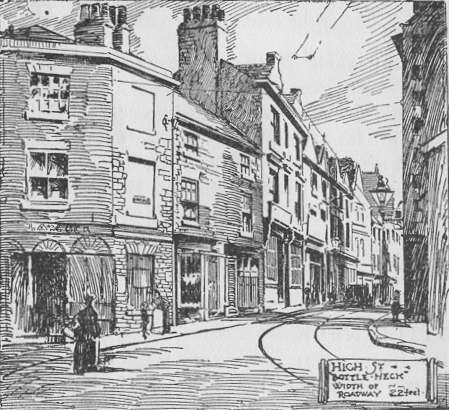Reminiscences of Rotherham
by G. Gummer, J.P.
« « prev
The shops in this section,i.e., from Laycock’s to Wigfield’s, were purchased in 1902 by the Corporation and added to the street.
This part of High street, which was only 20 feet wide. was known a the “ bottle neck.” As the traffic of the town increased in volume. congestion in the “Bottle Neck became dangerous, this being most noticeable on market days. The coming of the trams made it imperative that something should be done. In 1900, after succeeding in getting the Improvement and Property Committee appointed, I made it one of my first duties to see that the removal of the “ Bottle Neck and the Shambles should no longer be delayed. At the back of the property in this part of High street there used to be a narrow lane, known as Petty Coat Alley, where cloggers and other small shopkeepers carried on a thriving trade, especially on market days.
The Meat Shambles occupied the remaining portion of the site required for the improvements. In these shambles were to be found many of the best meat salesmen in Rotherham. They were considered to be the centre of gossip and scandal; the barbers had to give premier place to the butchers, as anything they did not know wasn’t worth knowing. The whole site was cleared in 1902 to make way for the Imperial Buildings.
MASON’S CORNER
Crossing Church Street and opposite Henry Wigfields we come to what is known as Mason’s Corner. These premises were low and old-fashioned and in the occupation of Richard Brooke, a jeweller and ironmonger. Years after the period to which I refer John Mason Bought these premises and erected a house and shop, which I have heard described as one of the finest jewellers’ shops in the North of England. It may interest my readers to learn that Richard Brooke was a brother of Mrs. Outwin, mother of the late Mrs. Willis of St. Leonard’s. It is from this source we get the name of Mrs. Brooke-Willis. a well-known and active worker in many social and charitable endeavours.Charles Yates, grocer, occupied the next premises,and then came a very old-fashioned shop, with a small bay window with small panes. such a shop as only a Barrie can describe. An old couple of the name of Lowe were the occupiers. All I can recollect seeing in their window were a few pocket knives. though I am told they also dealt in tobacco.
I am afraid of wearying my readers, yet I feel compelled to mention such men as William Arnott,the draper, a fine type of tradesman, respected and trusted as few men are, and Humphrey Davy, the chemist, who occupied the next premises. In those now occupied by Costellos, John Mason, the jeweller, formerly carried on his business. The next premises were those of Messrs Walter and Staplyton Smith, which still remain. We now come to William and Henry Bingley, family grocers, and Fred Fell, a provision merchant, and the ‘Stormy petrel’ of Rotherham. The “ Elephant and Castle, then conducted by John Wintle. who later became mine host of the Phoenix Hotel and still later of the “Red Lion “ ,came next. Then some dilapidated buildings in the occupation of what I believe to be the first multiple shop in Rotherhami, namely Messrs Scales and Salter. This completed the picture of High Street, in the sixties. » next
